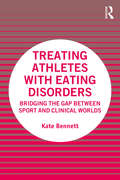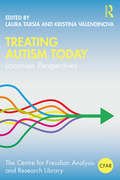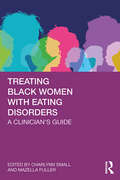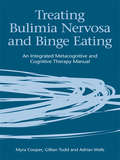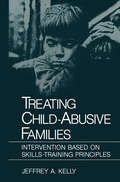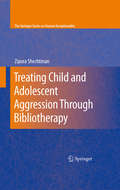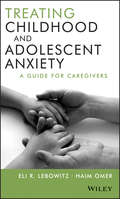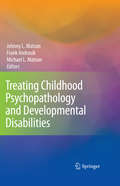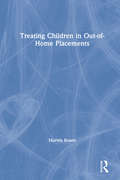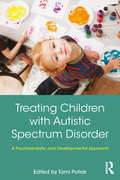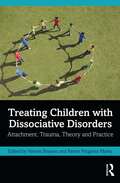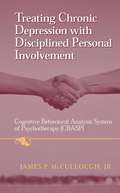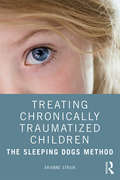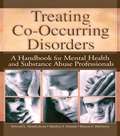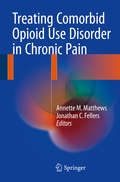- Table View
- List View
Treating Athletes with Eating Disorders: Bridging the Gap between Sport and Clinical Worlds
by Kate BennettThis book provides readers with concrete, tangible tools for treating athletes with eating disorders by discussing issues that are unique to this population and introducing specific ideas to help facilitate recovery among this population. Dr. Bennett integrates her experiences in sport and mental health to provide a comprehensive resource for all healthcare providers who support athletes with eating disorders. Traditional sport psychology interventions are translated into clinical action to help therapists align with the athletic identities of individuals recovering from eating disorders. From diagnosis and neurobiology to athletic identity and excellence, this book covers a range of topics to help readers build their own toolboxes of creative and clinically sound psychological interventions. This comprehensive guide provides professionals who are new to the field with essential knowledge pertaining to the treatment of eating disorders and offers experienced healthcare providers insight on treatment aspects that are unique to working with athletes.
Treating Athletes with Eating Disorders: Bridging the Gap between Sport and Clinical Worlds
by Kate BennettThis book provides readers with concrete, tangible tools for treating athletes with eating disorders by discussing issues that are unique to this population and introducing specific ideas to help facilitate recovery among this population. Dr. Bennett integrates her experiences in sport and mental health to provide a comprehensive resource for all healthcare providers who support athletes with eating disorders. Traditional sport psychology interventions are translated into clinical action to help therapists align with the athletic identities of individuals recovering from eating disorders. From diagnosis and neurobiology to athletic identity and excellence, this book covers a range of topics to help readers build their own toolboxes of creative and clinically sound psychological interventions. This comprehensive guide provides professionals who are new to the field with essential knowledge pertaining to the treatment of eating disorders and offers experienced healthcare providers insight on treatment aspects that are unique to working with athletes.
Treating Autism Today: Lacanian Perspectives (The Centre for Freudian Analysis and Research Library (CFAR))
by Laura TarsiaDrawing together an international range of psychoanalytic practitioners, this collection provides a critique of mainstream models of autism, looking at the conceptual and ideological underpinnings of the behavioural and cognitive approaches popular today. The first book to provide a psychoanalytic unpacking of standard non-analytic approaches, it offers a series of critical essays on mainstream assumptions, examining their history, foundations, and validity from a variety of angles. The authors consider, from the Lacanian perspective, the hypothesis of the biological-genetic causality of autism, as well as the claims of these approaches to offer effective therapy. These discussions are historically contextualised by an introduction and afterword that also provide pointers and references to further reading on Lacanian approaches to autism. Illustrated throughout by clinical examples, Treating Autism Today will be of interest to Lacanian clinicians and scholars, as well as psychotherapists, psychologists, and those working with children diagnosed as being on the autistic spectrum.
Treating Autism Today: Lacanian Perspectives (The Centre for Freudian Analysis and Research Library (CFAR))
by Laura Tarsia Kristina ValendinovaDrawing together an international range of psychoanalytic practitioners, this collection provides a critique of mainstream models of autism, looking at the conceptual and ideological underpinnings of the behavioural and cognitive approaches popular today. The first book to provide a psychoanalytic unpacking of standard non-analytic approaches, it offers a series of critical essays on mainstream assumptions, examining their history, foundations, and validity from a variety of angles. The authors consider, from the Lacanian perspective, the hypothesis of the biological-genetic causality of autism, as well as the claims of these approaches to offer effective therapy. These discussions are historically contextualised by an introduction and afterword that also provide pointers and references to further reading on Lacanian approaches to autism. Illustrated throughout by clinical examples, Treating Autism Today will be of interest to Lacanian clinicians and scholars, as well as psychotherapists, psychologists, and those working with children diagnosed as being on the autistic spectrum.
Treating Black Women with Eating Disorders: A Clinician's Guide
by Charlynn Small Mazella FullerThe first of its kind, this edited volume provides in-depth, culturally sensitive material intended for addressing the unique concerns of Black women with eating disorders in addition to comprehensive discussions and treatment guidelines for this population. The contributing authors—all of whom are Black professionals providing direct care to Black women—offer a range of perspectives to help readers understand the whole experience of their Black female clients. This includes not only discussion of their clients’ physical health but also of their emotional lives and the ways in which the stresses of racism, discrimination, trauma, and adverse childhood experiences can contribute to disordered eating. Through a wealth of diverse voices and stories, chapters boldly tackle issues such as stereotypes and acculturative stress. Clinicians of any race will gain new tools for assessing, diagnosing, and treating disordered eating in Black women and will be empowered to provide better care for their clients.
Treating Black Women with Eating Disorders: A Clinician's Guide
by Charlynn Small Mazella FullerThe first of its kind, this edited volume provides in-depth, culturally sensitive material intended for addressing the unique concerns of Black women with eating disorders in addition to comprehensive discussions and treatment guidelines for this population. The contributing authors—all of whom are Black professionals providing direct care to Black women—offer a range of perspectives to help readers understand the whole experience of their Black female clients. This includes not only discussion of their clients’ physical health but also of their emotional lives and the ways in which the stresses of racism, discrimination, trauma, and adverse childhood experiences can contribute to disordered eating. Through a wealth of diverse voices and stories, chapters boldly tackle issues such as stereotypes and acculturative stress. Clinicians of any race will gain new tools for assessing, diagnosing, and treating disordered eating in Black women and will be empowered to provide better care for their clients.
Treating Bulimia Nervosa and Binge Eating: An Integrated Metacognitive and Cognitive Therapy Manual
by Myra Cooper Gillian Todd Adrian WellsTreating Bulimia Nervosa and Binge Eating explains how cognitive therapy can be used to treat those suffering from bulimia nervosa. The manual provides a step-by-step treatment guide, incorporating a number of case examples offering detailed explanations of the treatment process, questionnaires, worksheets and practical exercises for the client, which will provide a framework and focus for therapy. The authors use existing techniques, as well as new integrated cognitive and metacognitive methods developed from their recent research, to take the therapist from initial assessment to the end of treatment and beyond, with chapters covering: engagement and motivation case formulation and socialisation detached mindfulness strategies positive and negative beliefs. This practical guide will allow those treating patients with bulimia nervosa to take advantage of recent developments in the field and will be an essential tool for all therapists working with this eating disorder.
Treating Bulimia Nervosa and Binge Eating: An Integrated Metacognitive and Cognitive Therapy Manual
by Myra Cooper Gillian Todd Adrian WellsTreating Bulimia Nervosa and Binge Eating explains how cognitive therapy can be used to treat those suffering from bulimia nervosa. The manual provides a step-by-step treatment guide, incorporating a number of case examples offering detailed explanations of the treatment process, questionnaires, worksheets and practical exercises for the client, which will provide a framework and focus for therapy. The authors use existing techniques, as well as new integrated cognitive and metacognitive methods developed from their recent research, to take the therapist from initial assessment to the end of treatment and beyond, with chapters covering: engagement and motivation case formulation and socialisation detached mindfulness strategies positive and negative beliefs. This practical guide will allow those treating patients with bulimia nervosa to take advantage of recent developments in the field and will be an essential tool for all therapists working with this eating disorder.
Treating Child-Abusive Families: Intervention Based on Skills-Training Principles (Nato Science Series B:)
by Jeffrey A. KellyDuring the past ten years, the problem of child abuse has been the subject of increased attention both in the professional community and among the general public. The reasons for this widespread recogni tion are clear. First, professionals of many disciplines deal with child abusive families and do so in a variety of ways: Physicians, hospital staff, and teachers are often the first to assess a child as the victim of abuse; social workers and child-protective personnel investigate cases of suspected abuse; court and legal authorities make determinations concerning the needs of an abused child; and mental health profes sionals, including psychologists, social workers, and family coun selors, often have responsibility for treating abusive families. Few clinical problems have received this kind of widespread interdisci plinary recognition and, given the nature and seriousness of child abusive behavior, few problems receive such intensive attention within each profession's literature. A second factor responsible for increased study of child abuse is the fact that violence directed toward children is probably the most extreme form of family dysfunction seen by counselors, therapists, and other practitioners. While other types of child-management and anger-control problems occur far more frequently, the consequences of child-abusive behavior are much more serious than the conse quences of other problems seen in child or family clinics. It has been v vi PREFACE estimated that as many as 550,000 children are the targets of parental abuse in the country each year (Helfer & Kemper, 1976).
Treating Child and Adolescent Aggression Through Bibliotherapy (The Springer Series on Human Exceptionality #Vol. 79)
by Zipora ShechtmanAntisocial acts by children and teens are on the rise – from verbal abuse to physical bullying to cyber-threats to weapons in schools. Strictly punitive responses to aggressive behaviour may even escalate a situation, leaving peers, parents, and teachers feeling helpless.This unique volume conceptualizes aggression as a symptom of underlying behavioural and emotional problems and examines the psychology of perpetrators and the power dynamics that foster intentionally hurtful behaviour in young people. It details for readers how bibliotherapy offers relevant, innovative, and flexible treatment – as a standalone intervention or as a preventive method in conjunction with other forms of treatment – and can be implemented with individuals and groups, parents, teachers, and even rivals.This unique, must-have resource is essential reading for school psychologists, school counselors, social workers, and clinical child psychologists and any allied educational and mental health professionals who work with troubled youth.
Treating Childhood and Adolescent Anxiety: A Guide for Caregivers
by Eli R. Lebowitz Haim Omer"Lebowitz and Omer have taken the latest and most relevant scientific research and synthesized it into an essential read for caregivers of anxious children. Treating Childhood and Adolescent Anxiety: A Guide for Caregivers provides an 'inside look' at the nuts and bolts of cognitive behavioral therapy (CBT) for childhood anxiety—the treatment of choice among leading researchers and experts. The book is filled with analogies, examples, and practical advice that professionals and parents will refer back to over and over again." —Candice A. Alfano, PhD; Director, Sleep and Anxiety Center for Kids (SACK) Associate Professor, Department of Psychology, University of Houston Practical real-life solutions for children living with anxiety Focusing on the special role of the caregiver in achieving successful treatment Focusing on the treatment of childhood anxiety, both in one-on-one therapist to child treatment and within the family, Treating Childhood and Adolescent Anxiety: A Guide for Caregivers adopts an integrated approach presenting novel strategies to help mental health professionals and families create change and momentum in otherwise stagnant situations. This empowering guide offers practical, evidence-based, and theory-driven strategies for helping children to overcome anxiety, even if they resist treatment. Uniquely providing concrete advice for both the therapeutic and home environment, this insightful book covers: What to do when anxiety takes over the family School phobia and school refusal Working with highly dependent young adults Parental support and protection Creating and maintaining family boundaries A walk-through of The Supportive Parenting for Anxious Childhood Emotions (SPACE) Program Cognitive, behavioral, physiological, and emotion-based tools for treating anxiety Medication for childhood anxiety
Treating Childhood and Adolescent Anxiety: A Guide for Caregivers
by Eli R. Lebowitz Haim Omer"Lebowitz and Omer have taken the latest and most relevant scientific research and synthesized it into an essential read for caregivers of anxious children. Treating Childhood and Adolescent Anxiety: A Guide for Caregivers provides an 'inside look' at the nuts and bolts of cognitive behavioral therapy (CBT) for childhood anxiety—the treatment of choice among leading researchers and experts. The book is filled with analogies, examples, and practical advice that professionals and parents will refer back to over and over again." —Candice A. Alfano, PhD; Director, Sleep and Anxiety Center for Kids (SACK) Associate Professor, Department of Psychology, University of Houston Practical real-life solutions for children living with anxiety Focusing on the special role of the caregiver in achieving successful treatment Focusing on the treatment of childhood anxiety, both in one-on-one therapist to child treatment and within the family, Treating Childhood and Adolescent Anxiety: A Guide for Caregivers adopts an integrated approach presenting novel strategies to help mental health professionals and families create change and momentum in otherwise stagnant situations. This empowering guide offers practical, evidence-based, and theory-driven strategies for helping children to overcome anxiety, even if they resist treatment. Uniquely providing concrete advice for both the therapeutic and home environment, this insightful book covers: What to do when anxiety takes over the family School phobia and school refusal Working with highly dependent young adults Parental support and protection Creating and maintaining family boundaries A walk-through of The Supportive Parenting for Anxious Childhood Emotions (SPACE) Program Cognitive, behavioral, physiological, and emotion-based tools for treating anxiety Medication for childhood anxiety
Treating Childhood Psychopathology and Developmental Disabilities (Lecture Notes In Medical Informatics #Vol. 4)
by Frank Andrasik Johnny L. Matson Michael L. MatsonChild psychology is a constantly expanding field, with dozens of specialized journals devoted to major disorders springing up in recent years. With so much information available – and the prospect of overload inevitable – researchers and clinicians alike need to navigate the knowledge base with as much confidence as they do the nuances of diagnosis and their young clients’ complex social, emotional, and developmental worlds. Treating Childhood Psychopathology and Developmental Disabilities fills this need by summarizing and critiquing evidence-based treatment methods for pediatric patients from infancy through adolescence. After a concise history of evidence-based treatment, promising new trends, and legal/ethical issues involved in working with young people, well-known professors, practitioners, and researchers present the latest data in key areas of interest, including: (1) Cognitive-behavioral therapy and applied behavior analysis. (2) The effects of parenting in treatment outcomes. (3) Interventions for major childhood pathologies, including ADHD, PTSD, phobias, anxiety, depression, bipolar disorder, and conduct disorder. (4) Interventions for autistic spectrum disorders and self-injuring behaviors. (5) Techniques for improving communication, language, and literacy in children with developmental disabilities. (6) Treatments for feeding and eating disorders. This comprehensive volume is an essential resource for the researcher’s library and the clinician’s desk as well as a dependable text for graduate and postgraduate courses in clinical child, developmental, and school psychology. (A companion volume, Assessing Childhood Psychopathology and Developmental Disabilities, is also available.)
Treating Children in Out-of-Home Placements
by Marvin RosenIf you’re in the market for a detailed, pragmatic knowledge base for dealing with discipline, relationships with regulatory and funding agencies, and staff training, you’ll find all you need and more in Treating Children in Out-of-Home Placements. This unique and insightful volume gives you the information you need to successfully manage quality assessment and improvement in out-of-home placements, especially in a managed care environment.Treating Children in Out-of-Home Placements reviews for you the field of residential treatment of adolescents in the child welfare system. With this crucial knowledge base, you’ll be equipped to face and surmount the challenges that accompany the provision of services to behaviorally disturbed youngsters. Some of the areas you’ll become fluent in are: approaches to child welfare for children at risk models of treatment family counseling diagnostic criteria for conduct and behavior disorders psychotropic medication training staff to become agents of changeFor over 150 years, we’ve seen the aftershocks of a problematic system for treating children placed in the custody of child welfare. Through treating Children in Out-of-Home Placements, you can understand the problems of implementing and administering such a program. You will want to open this book and place yourself and your staff members on the road to a more ideal plan of care for children placed in custody.
Treating Children in Out-of-Home Placements
by Marvin RosenIf you’re in the market for a detailed, pragmatic knowledge base for dealing with discipline, relationships with regulatory and funding agencies, and staff training, you’ll find all you need and more in Treating Children in Out-of-Home Placements. This unique and insightful volume gives you the information you need to successfully manage quality assessment and improvement in out-of-home placements, especially in a managed care environment.Treating Children in Out-of-Home Placements reviews for you the field of residential treatment of adolescents in the child welfare system. With this crucial knowledge base, you’ll be equipped to face and surmount the challenges that accompany the provision of services to behaviorally disturbed youngsters. Some of the areas you’ll become fluent in are: approaches to child welfare for children at risk models of treatment family counseling diagnostic criteria for conduct and behavior disorders psychotropic medication training staff to become agents of changeFor over 150 years, we’ve seen the aftershocks of a problematic system for treating children placed in the custody of child welfare. Through treating Children in Out-of-Home Placements, you can understand the problems of implementing and administering such a program. You will want to open this book and place yourself and your staff members on the road to a more ideal plan of care for children placed in custody.
Treating Children with Autistic Spectrum Disorder: A psychoanalytic and developmental approach
by Tami PollakTreating Children with Autistic Spectrum Disorder: A Psychoanalytic and Developmental Approach outlines a unique model, the product of over twenty years of experience in working with children with this diagnosis within "Shaked" - a multi-professional educational-therapeutic day-car unit in Israel. This book provides a comprehensive overview of this model and the psychoanalytic-developmental perspective underpinning it, which weaves together the various professional views into a single fabric integrating a therapeutic network which encompasses each and every aspect of the child's development. Drawing on psychoanalytic and developmental psychology, each chapters is devoted to the daily problems that arise when working with ASD children, such as weaning and toilet training, as well as the effects of ASD on wider family functioning, all in the context of administering treatment to young children in day-care and other non-residential settings. Treating Children with Autistic Spectrum Disorder offers an essential, practical guide which will be an asset to any clinician working with young children on the autistic spectrum, as well as the parents and siblings of these children.
Treating Children with Autistic Spectrum Disorder: A psychoanalytic and developmental approach
by Tami PollakTreating Children with Autistic Spectrum Disorder: A Psychoanalytic and Developmental Approach outlines a unique model, the product of over twenty years of experience in working with children with this diagnosis within "Shaked" - a multi-professional educational-therapeutic day-car unit in Israel. This book provides a comprehensive overview of this model and the psychoanalytic-developmental perspective underpinning it, which weaves together the various professional views into a single fabric integrating a therapeutic network which encompasses each and every aspect of the child's development. Drawing on psychoanalytic and developmental psychology, each chapters is devoted to the daily problems that arise when working with ASD children, such as weaning and toilet training, as well as the effects of ASD on wider family functioning, all in the context of administering treatment to young children in day-care and other non-residential settings. Treating Children with Autistic Spectrum Disorder offers an essential, practical guide which will be an asset to any clinician working with young children on the autistic spectrum, as well as the parents and siblings of these children.
Treating Children with Dissociative Disorders: Attachment, Trauma, Theory and Practice
by Valerie SinasonThis book provides a comprehensive overview of research into dissociation in children and adolescents and challenges conventional ideas about complex behaviours. Offering a new perspective to those who are unfamiliar with dissociation in children, and challenging prevalent assumptions for those who are experienced in the field, the editors encourage the professional to ask questions about the child’s internal experiences beyond a diagnosis of the external symptoms. Chapters bring together a range of international experts working in the field, and interweave theories, practice, and challenging and complex case material, as well as identifying mistakes that therapists can avoid while working with children who dissociate. Filled with practical tools and examples, this book is a vital resource for professionals to enrich their practice with children who dissociate.
Treating Children with Dissociative Disorders: Attachment, Trauma, Theory and Practice
by Valerie Sinason Renée Potgieter MarksThis book provides a comprehensive overview of research into dissociation in children and adolescents and challenges conventional ideas about complex behaviours. Offering a new perspective to those who are unfamiliar with dissociation in children, and challenging prevalent assumptions for those who are experienced in the field, the editors encourage the professional to ask questions about the child’s internal experiences beyond a diagnosis of the external symptoms. Chapters bring together a range of international experts working in the field, and interweave theories, practice, and challenging and complex case material, as well as identifying mistakes that therapists can avoid while working with children who dissociate. Filled with practical tools and examples, this book is a vital resource for professionals to enrich their practice with children who dissociate.
Treating Chronic Depression with Disciplined Personal Involvement: Cognitive Behavioral Analysis System of Psychotherapy (CBASP)
by James P. McCullough, Jr.This volume describes in detail what disciplined personal involvement is and how it is administered. It empirically challenges one of the oldest prohibitions in the field of psychotherapy: the personal involvement taboo. The book was written during a current four-year national clinical trial sponsored by NIMH involving 910 chronically depressed outpatients being treated at eight sites in the U.S.
Treating Chronically Traumatized Children: The Sleeping Dogs Method
by Arianne StruikWhen children refuse or seem unable to talk about their traumatic memories, it might be tempting to ‘let sleeping dogs lie’. However, if left untreated, the memories of childhood abuse and neglect can have a devastating effect on the development of children and young people. How can these children be motivated and engage in trauma-focused therapy? Treating Chronically Traumatized Children: The Sleeping Dogs Method describes a structured method to overcome resistance and enable children to wake these sleeping dogs safely, so these children heal from their trauma. The ‘Sleeping Dogs method’ is a comprehensive approach to treating chronically traumatized children, first preparing the child to such an extent that he or she can engage in therapy to process traumatic memories, then by the trauma processing and integration phase. Collaboration with the child’s network, the child’s biological family including the abuser-parent and child protection services, are key elements of the 'Sleeping Dogs method'. The underlying theory about the consequences of traumatization, such as disturbed attachment and dissociation, is described in a comprehensive, easy-to-read manner illustrated with case studies and is accompanied by downloadable worksheets. This new edition has been updated to include the clinical experience in working with this method and the most recent literature and research, as well as entirely new chapters that apply the ‘Sleeping Dogs method’ to the experiences of children in foster care and residential care, and those with an intellectual disability. Treating Chronically Traumatized Children will have a wide appeal, including psychologists, psychiatrists, psychotherapists, counsellors, family therapists, social workers, child protection, frontline, foster care and youth workers, inpatient and residential staff and (foster or adoptive) parents.
Treating Chronically Traumatized Children: The Sleeping Dogs Method
by Arianne StruikWhen children refuse or seem unable to talk about their traumatic memories, it might be tempting to ‘let sleeping dogs lie’. However, if left untreated, the memories of childhood abuse and neglect can have a devastating effect on the development of children and young people. How can these children be motivated and engage in trauma-focused therapy? Treating Chronically Traumatized Children: The Sleeping Dogs Method describes a structured method to overcome resistance and enable children to wake these sleeping dogs safely, so these children heal from their trauma. The ‘Sleeping Dogs method’ is a comprehensive approach to treating chronically traumatized children, first preparing the child to such an extent that he or she can engage in therapy to process traumatic memories, then by the trauma processing and integration phase. Collaboration with the child’s network, the child’s biological family including the abuser-parent and child protection services, are key elements of the 'Sleeping Dogs method'. The underlying theory about the consequences of traumatization, such as disturbed attachment and dissociation, is described in a comprehensive, easy-to-read manner illustrated with case studies and is accompanied by downloadable worksheets. This new edition has been updated to include the clinical experience in working with this method and the most recent literature and research, as well as entirely new chapters that apply the ‘Sleeping Dogs method’ to the experiences of children in foster care and residential care, and those with an intellectual disability. Treating Chronically Traumatized Children will have a wide appeal, including psychologists, psychiatrists, psychotherapists, counsellors, family therapists, social workers, child protection, frontline, foster care and youth workers, inpatient and residential staff and (foster or adoptive) parents.
Treating Co-Occurring Disorders: A Handbook for Mental Health and Substance Abuse Professionals
by Sharon EkleberryIn the real world, caseloads include clients with substance abuse, psychiatric, and co-occurring disorders. Here you'll find reliable information and informative case examples to help you manage your caseload more effectively! Caseloads that include mental health, substance use, and co-occurring disorders are becoming more and more common, yet most texts in this area focus on one specific type of disorder. This unique handbook reflects the reality facing mental health and substance abuse professionals in their daily practices, focusing on how to effectively manage caseloads that include individuals with vastly differing levels of functioning. Providing diagnostic criteria, treatment regimens, and a great deal more, Treating Co-Occurring Disorders: A Handbook for Mental Health and Substance Abuse Professionals is an exceptional single source for useful information on handling all of these types of cases and clients. Treating Co-Occurring Disorders: A Handbook for Mental Health and Substance Abuse Professionals describes the psychiatric and substance use disorders that commonly co-occur and examines the evolution of co-occurring concepts and treatment. It provides an overview of relapse prevention and symptom management models for use with clients with co-occurring disorders and another covering mental health and substance abuse recovery movements. Treating Co-Occurring Disorders: A Handbook for Mental Health and Substance Abuse Professionals will bring you closer to topics that impact day-to-day practice, including: conducting comprehensive assessments for individuals with psychiatric and substance use symptoms providing individual, group, family, and case management interventions for clients of differing levels of function who exhibit psychiatric and substance abuse symptoms identifying standard interventions for all clients with co-occurring disorders measuring change and establishing reasonable treatment outcome performance standards for these clients supervising staff who work with multifarious caseloads From the authors: "Currently, most mental health and substance abuse professionals are aware of how to effectively assess and treat individuals with diagnoses for which they were trained. However, few therapists exclusively have clients who manifest only psychiatric or substance abuse symptoms. This book provides information and case examples concerning how to effectively manage a caseload composed of individuals with substance abuse, psychiatric, and co-occurring disorders. It presents strategies for providing comprehensive assessments for these individuals. Additionally, it describes how to provide effective case management as well as individual, group, and family treatment for individuals with multiple disorders and levels of function, and provides information on interacting effectively with the mental health and substance abuse recovery communities." Tables, figures, and a generous portion of intriguing case descriptions will help you apply the information in this useful volume to your own work.
Treating Co-Occurring Disorders: A Handbook for Mental Health and Substance Abuse Professionals
by Sharon EkleberryIn the real world, caseloads include clients with substance abuse, psychiatric, and co-occurring disorders. Here you'll find reliable information and informative case examples to help you manage your caseload more effectively! Caseloads that include mental health, substance use, and co-occurring disorders are becoming more and more common, yet most texts in this area focus on one specific type of disorder. This unique handbook reflects the reality facing mental health and substance abuse professionals in their daily practices, focusing on how to effectively manage caseloads that include individuals with vastly differing levels of functioning. Providing diagnostic criteria, treatment regimens, and a great deal more, Treating Co-Occurring Disorders: A Handbook for Mental Health and Substance Abuse Professionals is an exceptional single source for useful information on handling all of these types of cases and clients. Treating Co-Occurring Disorders: A Handbook for Mental Health and Substance Abuse Professionals describes the psychiatric and substance use disorders that commonly co-occur and examines the evolution of co-occurring concepts and treatment. It provides an overview of relapse prevention and symptom management models for use with clients with co-occurring disorders and another covering mental health and substance abuse recovery movements. Treating Co-Occurring Disorders: A Handbook for Mental Health and Substance Abuse Professionals will bring you closer to topics that impact day-to-day practice, including: conducting comprehensive assessments for individuals with psychiatric and substance use symptoms providing individual, group, family, and case management interventions for clients of differing levels of function who exhibit psychiatric and substance abuse symptoms identifying standard interventions for all clients with co-occurring disorders measuring change and establishing reasonable treatment outcome performance standards for these clients supervising staff who work with multifarious caseloads From the authors: "Currently, most mental health and substance abuse professionals are aware of how to effectively assess and treat individuals with diagnoses for which they were trained. However, few therapists exclusively have clients who manifest only psychiatric or substance abuse symptoms. This book provides information and case examples concerning how to effectively manage a caseload composed of individuals with substance abuse, psychiatric, and co-occurring disorders. It presents strategies for providing comprehensive assessments for these individuals. Additionally, it describes how to provide effective case management as well as individual, group, and family treatment for individuals with multiple disorders and levels of function, and provides information on interacting effectively with the mental health and substance abuse recovery communities." Tables, figures, and a generous portion of intriguing case descriptions will help you apply the information in this useful volume to your own work.
Treating Comorbid Opioid Use Disorder in Chronic Pain
by Annette M. Matthews Jonathan C. FellersThis in-depth text addresses how to approach and treat the chronic pain patient struggling with problematic opioid use. It discusses the approach for patients who may be at high risk of problematic use, such as those with a history of mental illness or substance use disorder. The first part covers diagnosis and treatment, focusing on common best practices that practitioners can adapt to any practice. Two of the chapters detail alternative and replacement therapies for opioid. Two more cover special issues in the treatment of women and older patients. The second part reviews the ethical, legal, regulatory, and policy issues surrounding the treatment of patients with comorbid pain and addiction. The book includes strategies for documentation that mitigate the risk of legal issues or ethical boundary crossings. The last part of the book addresses treating comorbid pain and opioid use disorder in different medical settings and the treatment of co-occurring mental illnesses and substance abuse. Treating Comorbid Opioid Use Disorder in Chronic Pain is of great value to psychiatrists, pain physicians, primary care providers, social workers, drug rehabilitation centers, and other behavioral health professionals.
